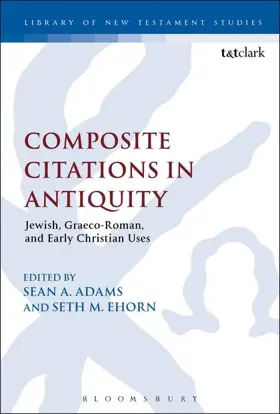

Composite Citations in Antiquity: Volume 1: Jewish, Graeco-Roman, and Early Christian Uses
in Library of New Testament Studies
Pages
224
Publisher
T&T Clark
Published
11/19/2015
ISBN-13
9780567657978
Sean A. Adams and Seth M. Ehorn have drawn together an exciting range of contributors to evaluate the use of composite citations in Early Jewish, Greco-Roman, and Early Christian authors (up through Justin Martyr). The goal is to identify and describe the existence of this phenomenon in both Greco-Roman and Jewish literature. The introductory essay will help to provide some definitional parameters, although the study as a whole will seek to weigh in on this question. The contributors seek to address specific issues, such as whether the quoting author created the composite text or found it already constructed as such. The essays also cover an exploration of the rhetorical and/or literary impact of the quotation in its present textual location, and the question of whether the intended audiences would have recognised and 'reverse engineered' the composite citation and as a result engage with the original context of each of the component parts.
In addition to the specific studies, Professor Christopher Stanley provides a summary reflection on all of the essays in the volume along with some implications for New Testament studies.
In addition to the specific studies, Professor Christopher Stanley provides a summary reflection on all of the essays in the volume along with some implications for New Testament studies.
- Table Of Contents
- List of Abbreviations
- Chapter 1: What is a Composite Citation?: An Introduction: Sean A. Adams, University of Glasgow, UK and Seth M. Ehorn, Wheaton University, USA
- Chapter 2: Greek Education and Composite Citations of Homer: Sean A. Adams, University of Edinburgh, UK
- Chapter 3: Composite Citations in Plutarch: Seth M. Ehorn, Wheaton University, USA
- Chapter 4: Citation in Elite Roman Epistolary Writing: The Letters of Cicero, Seneca, and Pliny: Margaret H. Williams, University of Edinburgh, UK
- Chapter 5: Composite Citations in Philo of Alexandria: James R. Royse, Claremont School of Theology, USA
- Chapter 6: Composite Citations in the Damascus Document: Jonathan D. H. Norton, Heythrop College, UK
- Chapter 7: Composite Citations in the Septuagint Apocrypha: Sean A. Adams and Seth M. Ehorn
- Chapter 8: Composite Citations in Jewish Pseudepigraphic Works: Re-presenting Legal Traditions in the Second Temple Period: Garrick V. Allen, Kirchliche Hochschule Wuppertal, Germany
- Chapter 9: Composite Features and Citations in Justin Martyr's Textual Composition: Philippe Bobichon, Institut de Recherche et d'Histoire des Textes, France
- Chapter 10: The Testimonia Hypothesis and Composite Citations: Martin C. Albl, Presentation College, USA
- Chapter 11: Composite Citations: Retrospect and Prospect: Christopher D. Stanley, St. Bonaventure University, USA
- Bibliography
- Index
Inner Books
This physical volume has several internal sections, each of which has been reviewed independently
- What is a Composite Citation?: An Introduction by Sean A. Adams and Seth M. Ehorn
- Greek Education and Composite Citations of Homer by Sean A. Adams
- Composite Citations in Plutarch by Seth M. Ehorn
- Citation in Elite Roman Epistolary Writing: The Letters of Cicero, Seneca, and Pliny by Margaret H. Williams
- Composite Citations in Philo of Alexandria by James R. Royse
- Composite Citations in the Damascus Document by Jonathan D. H. Norton
- Composite Citations in the Septuagint Apocrypha by Sean A. Adams and Seth M. Ehorn
- Composite Citations in Jewish Pseudepigraphic Works: Re-presenting Legal Traditions in the Second Temple Period by Garrick V. Allen
- Composite Features and Citations in Justin Martyr's Textual Composition by Philippe Bobichon
- The Testimonia Hypothesis and Composite Citations by Martin C. Albl
- Composite Citations: Retrospect and Prospect by Christopher D. Stanley